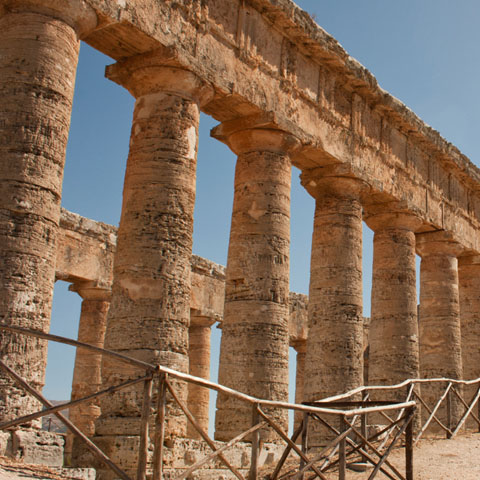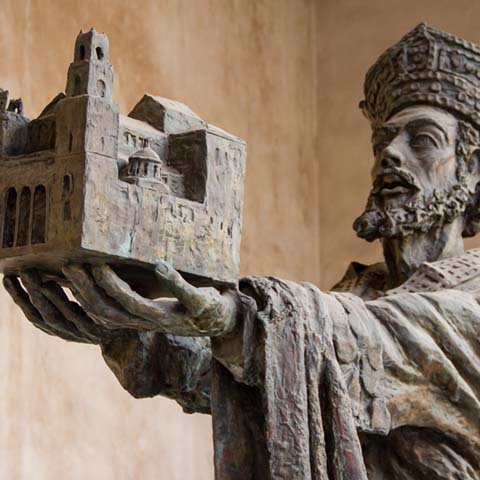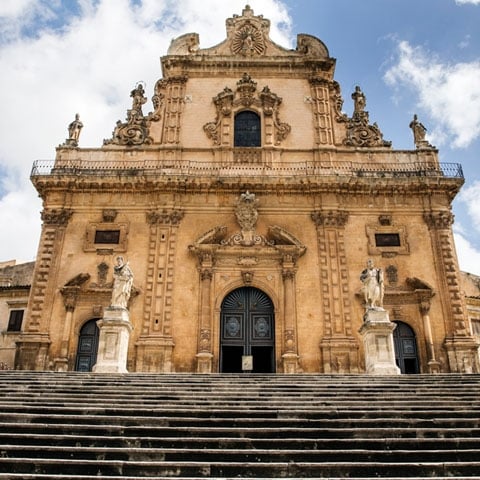Sicily – History
Sicily is one of the most attractive regions of Italy. The largest island in the Mediterranean Sea, Sicily is strategically located approximately halfway between Gibraltar and the Canal of Suez. Its geographical location made this beautiful island a true crossing point of cultures that shaped the history and identity of its people.
In fact, the island saw the rise and fall of numerous populations, including Greek, Carthaginians, Romans, Vandals and Ostrogoth, Byzantines, Arabs, Normans, and more.
The term Sicily derives from the Sicilian populations who inhabited the eastern part of the island, and from Sicania, a term referring to the western part. For centuries, Sicily was administratively divided into three “valleys” or districts, Mazzara, Demona, and Noto. In 1817 the territory was divided into seven provinces, and this new territorial division remained unaltered until 1927 when the additional provinces of Enna and Ragusa were established.
Prehistory of Sicily
The first documentation of ancient inhabitants are dated to the Lower Paleolithic and were discovered in the 60s in various locations across the island. The vast majority of these artifacts had been discovered in the province of Agrigento and between Menfi and Sciacca.
Subsequently, other sites were discovered in the province of Catania and near Ragusa. However, these artifacts are rather limited findings and their provenience is not clearly defined. Moreover, there are no testimonies to document the presence of inhabitants in the Middle Paleolithic.
Numerous complexes related to the Upper Paleolithic and Mesolithic have been found in many locations. To the Upper Paleolithic is attributed the industry of Fontana Nuova in Ragusa, while other sites have been reported in Siracusa, Trapani, and Palermo.
Four important burial sites have been discovered in the provinces of Messina and Siracusa, more precisely the shelter of Sperlinga, the cave of San Teodoro and the cave of Corruggi. These burial sites featured the presence of numerous forms of art executed on limestone and slabs. The motifs engraved have mainly a geometric character and rarely a naturalistic nature, yet their presence is of extreme importance from an archaeological point of view.
It is also worth mentioning the cave Acqua Fitusa in Agrigento and the grotto Cala dei Genovesi in Levanzo, where representations of animals have been discovered, while in other caves across the island complex representations of human characters and animals have been discovered, especially in the province of Palermo.
All these findings are difficult to date because of the complex culture of the region. Nevertheless, experts attributed them to the Mesolithic and Lower Paleolithic eras.
The Mesolithic is especially attested in the grotto of Uzzo where, among other artifacts, have been discovered a series of burial sites containing remains of adults, children, and infants.
The Neolithic, on the other hand, left a more important legacy that demonstrates the important role Sicily played during this time, mainly because of its strategic position. The main findings belong to the Neolithic cultures of Stentinello and Diana.
Starting from the third millennium BC, the cultural aspects of the Aeolian Islands and the rest of the Sicily were diversified. A particularly important phenomenon is the emersion of bell-shaped ceramics, especially in the area of Conca d’Oro.
Of particular importance is the impressive anakotronof Pantilica, which is a megalithic residential building hanging over one of the most spectacular necropolises in Sicily and consisting of approximately 5000 graves.
From the Iron Age onwards, the evidence of Phoenician and Greek colonies were found in various parts of the island.
History of Sicily
Throughout its history, Sicily has had different names. The oldest name of the region, suggested by the conformation of the island, was Trinacria. Initially inhabited by Siculi, Sicani, and Elymians, Sicily opened its gates to the Phoenician colonization in the ninth century BC, then to the Greek populations in 734 BC.
The Phoenician presence initially had a commercial character based on seaports, and it became stable only from the ninth century BC thanks to the foundation of the first cities in the region. In the sixth century BC, the Phoenician cities entered the political orbit of Carthage, while the Greek settlements started to emerge in the eastern part of the island.
Between 734 and 733 BC, it is noteworthy to mention the foundation of Syracuse by Corinthians, while another important city, Gela, was founded by Cretans in 689 BC.
The various Greek colonies never reached a political unity and the island witnessed numerous wars. Nevertheless, Sicily managed to establish intense commercial relations with many settlements in Southern Italy and with Rome.
In the fourth century BC began a true period of conflict between the Phoenicians and Greeks for the control of the Mediterranean trade. Greeks gained more control over the region, defeated Etruscans, and subsequently extended their influence to southern Italy. Syracuse, on the other hand, became a true power.
This raised the interest in Rome and, in 212 BC, the Roman consul Marcello gained control over Syracuse. Once entered in Sicily, Rome gained possession of the entire island to which it attributed the status of Roman province. As a result, almost all Sicilian cities became subject to the payment of a tribute, but managed to maintain a considerable autonomy.
The Latin Law had been introduced in the region by Caesar, while Augustus introduced the region in the provinces of the Senate. This strengthened the Roman domination which led to the colonization of other cities as well. In 212 AD, the Sicilians gained Roman citizenship as all the other inhabitants of the Empire.
The decline of the Roman Empire was reflected on the island by the occupation of the Vandals in 468. Soon after, in 491, the island was occupied by the Ostrogoth, and during this period, Sicily knew relative stability. Protected by military forces, Sicily reinforced its commercial role and became once more the key element for trade in the Mediterranean.
Nevertheless, Sicily was occupied by Belisario at the beginning of the Gothic War and it became a military bastion. Taking advantage of the island’s weakness, the Arab populations debilitated the economy and shocked the demographic distribution, yet they left an important cultural legacy that shaped the uniqueness of the region.
With the advent of the Byzantine domination, Sicily entered a period of fiscal rigor and religious intolerance. Greek language, culture, and customs penetrated deeply into the Sicilian society, and this second Hellenization made the island the center of the Byzantine empire who transferred its capital from Constantinople to Syracuse.
Still attracted by the strategic importance of the island, the Arabs embarked on a new invasion, giving a holy character to the war. Although less prepared from a military point of view, they managed to complete the conquest at the beginning of the tenth century, taking over the cities of Mazara, Palermo, Messina, Enna, Syracuse, and Taormina. Under the Arab rule, Sicily gained the status of independent principality while the population gained civil and private rights, including religious freedom.
Moreover, the Arabs also contributed to the economic development of the island, especially regarding some industries such as agriculture, crafts, and trade.
Although Sicily was blooming, the Normans, supported by the Roman Church, started to engage into an anti-Muslim offensive and conquered the island between 1061 and 1091.
Under the Norman domination in Sicily, the feudal regime was introduced and authority was given to the officials. This period also ensured religious freedom, and the island experienced a vigorous recovery, with Palermo becoming the center of the region.
The Sicilian crown passed to the Anjou in 1266, and during this period the islands reached a state of stagnant economic downturn.
The Anjou rule didn’t last long in Sicily. Charles of Anjou tried to bring stability to the island and revive trade, but his tax policy and the transfer of the capital to Naples didn’t bring the expected results. As a consequence, the insurrection of the Vespers broke out in Palermo in 1282. This revolt marked a great turning point and Sicily entered under the influence of Spain. The region remained isolated from the rest of Italy until the nineteenth century.
During this period and on an internal level, the union of the crowns of Aragon and Sicily established the viceroy government in 1415. At this point began a process of partial recovery of power, which led to a certain economic and demographic revival as well.
The Sicilian nobility assumed an attitude of collaboration with the Spanish monarchy and preserved a vicious role in the viceroy. Nobility gained and guaranteed social control to the crown by granting economic privileges, including the liberalization of the grain trade which led to a sharp rise in property tax.
In fact, in a fiery search for money, the Spanish crown proceeded with a wave of sales of noble titles and rights on the lands, causing the wide spread of the ranks of baronage and the further social strengthening of the nobility.
As a result, nobility raised the financial burden on the people, and the cities became the point of confluence of the crisis and the lowest social classes exploded with a revolt. The conflict included Palermo and Messina, but the Spanish garrison managed to escape until 1678.
After the Treaty of Utrecht in 1713, Sicily passed to the Duke of Savoy, but shortly thereafter it was given to Austria in exchange for Sardinia. All changed in 1734 when the Kingdom of Sicily was reunited with Naples under the reign of Charles of Bourbon.
Sicily remained under the Bourbon even in the periods when they lost control in southern Italy, until 1812, when Bentinck instituted a liberal constitution and abolished the feudal rights. Following the defeat of the French and return of the sovereign to Naples, Ferdinand IV decreed in 1816 the revocation of the Constitution and the instauration of the Kingdom of the Two Sicilies.
The decision wasn’t welcome on the island, and Palermo claimed its autonomy and the restoration of the Constitution. Despite the positive economic, social, and institutional improvements that followed, the gap between the monarchy and the other significant political forces was no longer overcome. As such, Sicily witnessed Palermo’s uprising and the anti-war insurrection between 1831 and 1848. As a result, the monarchy didn’t find any type of support in the region to fight against Garibaldi’s troops, and in 1860 Sicily joined the union of the Kingdom of Italy.
The changes made by the Italian state were impressive, albeit inferior to those achieved in the other regions of the peninsula.
In the years following the First World War, Sicily began the massive emigration to the United States of America, and the difficult economic and social conditions caused serious agitation among the population. After the Second World War Sicily represented the starting point for the liberation of Italy by the allied forces.
This process ended with the resumption of the political life and rise of a strong separatist movement. The separatist movement collapsed after a short time, yet the Mafia phenomenon started to gain strength. In 1948 Sicily became an autonomous region with special status, and in 1950 was implemented an agrarian reform in the attempt to eliminate the Mafia. Nevertheless, this phenomenon proved an unexpected strength and adaptation to the new reality of the island and succeeded to establish an alliance with the political power.
Facing social and economic difficulties of the island, the Mafia became a powerful criminal organization that extended to the rest of the peninsula. In the second half of the twentieth century, Sicily became a strong presence in the Italian political and cultural life.
Archaeology in Sicily
Sicily preserves impressive remains from its past as a Greek and Phoenician colony. The most important archaeological sites are in Syracuse and Agrigento, where numerous temples are located. From all the archaeological remains of the greatest grandeur are, without a doubt, those of Greece.
Temples such as the Temple of Jupiter in Agrigento impresses with its characteristic columns, while the most archaic temples are located in Syracuse and boast artistic reliefs. The remains of an archaic Ionian temple was discovered on Ortigia Island.
Other important contributions of the Greek in Sicily are located almost everywhere throughout the island and include a couple of temples dedicated to Aphrodite, some acropolises and various sanctuaries.
Numerous interesting artifacts can be found in the Regional Archaeological Museum in Palermo, in the Archaeological Museum in Syracuse and in the Aeolian Regional Archaeological Museum in Lipari.
Travel Guides











